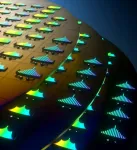(Press-News.org) Fifteen years ago, UC Santa Barbara electrical and materials professor John Bowers pioneered a method for integrating a laser onto a silicon wafer. The technology has since been widely deployed in combination with other silicon photonics devices to replace the copper-wire interconnects that formerly linked servers at data centers, dramatically increasing energy efficiency -- an important endeavor at a time when data traffic is growing by roughly 25% per year.
For several years, the Bowers group has collaborated with the group of Tobias J. Kippenberg at the Swiss Federal Institute of Technology (EPFL), within the Defense Advanced Research Projects Agency (DARPA) Direct On-Chip Digital Optical Synthesizer (DODOS) program. The Kippenberg group discovered "microcombs," a series of parallel, low-noise, highly stable laser lines. Each of the many lines of the laser comb can carry information, extensively multiplying the amount of data that can be sent by a single laser.
Recently, several teams demonstrated very compact combs by placing a semiconductor laser chip and a separate silicon nitride ring-resonator chip very close together. However, the laser and the resonator were still separate devices, made independently and then placed in close proximity to each other perfectly aligned, a costly and time-consuming process that is not scalable.
The Bowers lab has worked with the Kippenberg lab to develop an integrated on-chip semiconductor laser and resonator capable of producing a laser microcomb. A paper titled "Laser soliton microcombs heterogeneously integrated on silicon," published in the new issue of the journal Science, describes the labs' success in becoming the first to achieve that goal.
Soliton microcombs are optical frequency combs that emit mutually coherent laser lines -- that is, lines that are in constant, unchanging phase relative to each other. The technology is applied in the areas of optical timing, metrology and sensing. Recent field demonstrations include multi-terabit-per-second optical communications, ultrafast light detection and ranging (LiDAR), neuromorphic computing, and astrophysical spectrometer calibration for planet searching, to name several. It is a powerful tool that normally requires exceptionally high power and expensive lasers and sophisticated optical coupling to function.
The working principle of a laser microcomb, explained lead author Chao Xiang, a postdoctoral researcher and newly minted Ph.D. in Bowers's lab, is that a distributed feedback (DFB) laser produces one laser line. That line then passes through an optical phase controller and enters the micro-ring resonator, causing the power intensity to increase as the light travels around the ring. If the intensity reaches a certain threshold, non-linear optical effects occur, causing the one laser line to create two additional, identical lines on either side. Each of those two "side lines" creates others, leading to a cascade of laser-line generation. "You end up with a series of mutually coherent frequency combs," Xiang said -- and a vastly expanded ability to transmit data.
This research enables semiconductor lasers to be seamlessly integrated with low-loss nonlinear optical micro-resonators -- "low-loss" because the light can travel in the waveguide without losing a significant amount of its intensity over distance. No optical coupling is required, and the device is entirely electrically controlled. Importantly, the new technology lends itself to commercial-scale production, because thousands of devices can be made from a single wafer using industry standard complementary metal oxide semiconductor (CMOS)-compatible techniques. "Our approach paves the way for large-volume, low-cost manufacturing of chip-based frequency combs for next-generation high-capacity transceivers, datacenters, space and mobile platforms," the researchers stated.
The key challenge in making the device was that the semiconductor laser and the resonator, which generates the comb, had to be built on different material platforms. The lasers can be made only with materials from the III and V groups on the Periodic Table, such as indium phosphide, and the best combs can be made only from silicon nitride. "So, we had to find a way to put them together on a single wafer," Xiang explained.
Working sequentially on the same wafer, the researchers leveraged UCSB's heterogeneous integration process for making high-performance lasers on silicon substrate and the ability of their EPFL collaborators to make record ultra-low-loss high-Q silicon nitride micro-resonators using the "photonic damascene process" they developed. The wafer-scale process -- in contrast to making individual devices and then combining them one by one -- enables thousands of devices to be made from a single 100-mm-diameter wafer, a production level that can be scaled up further from the industry standard 200-mm- or 300-mm-diameter substrate.
For the device to function properly, the laser, the resonator and the optical phase between them must be controlled to create a coupled system based on the "self-injection locking" phenomenon. Xiang explained that the laser output is partially back-reflected by the micro-resonator. When a certain phase condition is achieved between the light from the laser and the back-reflected light from the resonator, the laser is said to be locked to the resonator.
Normally, back-reflected light harms laser performance, but here it is crucial for generating the microcomb. The locked laser light triggers soliton formation in the resonator and reduces the laser light noise, or frequency instability, at the same time. Thus, something harmful is transformed into a benefit. As a result, the team was able to create not only the first laser soliton microcomb integrated on a single chip, but also the first narrow-linewidth laser sources with multiple available channels on one chip.
"The field of optical comb generation is very exciting and moving very fast. It is finding applications in optical clocks, high-capacity optical networks and many spectroscopic applications," said Bowers, the Fred Kavli Chair in Nanotechnology and the director of the College of Engineering's Institute for Energy Efficiency. "The missing element has been a self-contained chip that includes both the pump laser and the optical resonator. We demonstrated that key element, which should open up rapid adoption of this technology."
"I think this work is going to become very big," said Xiang. The potential of this new technology, he added, reminds him of the way putting lasers on silicon 15 years ago advanced both research and industrial commercialization of silicon photonics. "That transformative technology has been commercialized, and Intel ships millions of transceiver products per year," he said. "Future silicon photonics using co-packaged optics will likely be a strong driver for higher-capacity transceivers using a large number of optical channels."
Xiang explained that the current comb produces about twenty to thirty usable comb lines and that the goal going forward will be to increase that number, "hopefully to get one hundred combined lines from each laser-resonator, with low power consumption."
Based on the soliton microcombs' low energy use and their ability to provide a large number of high-purity optical comb lines for data communications, said Xiang, "We believe that our achievement could become the backbone of efforts to apply optical frequency comb technologies in many areas, including efforts to keep up with fast-growing data traffic and, hopefully, slow the growth of energy consumption in mega-scale datacenters."
INFORMATION:
Optical frequency combs consist of light frequencies made of equidistant laser lines. They have already revolutionized the fields of frequency metrology, timing and spectroscopy. The discovery of ''soliton microcombs'' by Professor Tobias Kippenberg's lab at EPFL in the past decade has enabled frequency combs to be generated on chip. In this scheme, a single-frequency laser is converted into ultra-short pulses called dissipative Kerr solitons.
Soliton microcombs are chip-scale frequency combs that are compact, consume low power, and exhibit broad bandwidth. Combined with large spacing of comb "teeth", microcombs are uniquely ...
Conversations between seriously ill people, their families and palliative care specialists lead to better quality-of-life. Understanding what happens during these conversations - and particularly how they vary by cultural, clinical, and situational contexts - is essential to guide healthcare communication improvement efforts. To gain true understanding, new methods to study conversations in large, inclusive, and multi-site epidemiological studies are required. A new computer model offers an automated and valid tool for such large-scale scientific analyses.
Research results on this model were published today in PLOS ONE.
Developed by a team of computer scientists, clinicians and engineers at the University of Vermont, the approach - called CODYM ...
A study by Stanford University School of Medicine investigators hints that people with COVID-19 may experience milder symptoms if certain cells of their immune systems "remember" previous encounters with seasonal coronaviruses -- the ones that cause about a quarter of the common colds kids get.
These immune cells are better equipped to mobilize quickly against SARS-CoV-2, the coronavirus responsible for COVID-19, if they've already met its gentler cousins, the scientists concluded.
The findings may help explain why some people, particularly children, seem much more resilient than others to infection by SARS-CoV-2, the coronavirus that causes COVID-19. They also might make it possible ...
Scientists have developed a new technology to detect a wider variety of T cells that recognize coronaviruses, including SARS-CoV-2. The technology revealed that killer T cells capable of recognizing epitopes conserved across all coronaviruses are much more abundant in COVID-19 patients with mild disease versus those with more severe illness, suggesting a protective role for these broad-affinity T cells. The ability to distinguish T cells based on their affinities to SARS-CoV-2 could help scientists elucidate the disparity in COVID-19 outcomes and determine which COVID-19 patients will or will not exhibit a successful immune response ...
In a new Editorial, Peter Heeger, Christian Larsen, and Dorry Segev discuss recent evidence - including a recent Science Immunology study by Hector Rincon-Arevalo and colleagues - that points to a diminished immune response to COVID-19 vaccines among organ transplant recipients and others on immunosuppressive drug regimens. The authors note that this presents challenges at both the individual and population levels, since current vaccine protocols may not provide adequate protection to immunosuppressed patients - who could, in turn, become reservoirs for new and dangerous variants of the virus. As such, Heeger, Larsen, and Segev argue that developing vaccination strategies for transplant recipients should be a high priority in the next wave of research focused on fighting COVID-19. ...
ROCHESTER, Minn. -- Research by investigators at Mayo Clinic Cancer Center suggests that physicians should screen patients with lung cancer for MET amplification/overexpression before determining a treatment strategy. Their findings are published Cancer Discovery, a journal of the American Association for Cancer Research.
"In our research we found several lung cancer cases that were not responsive to standard chemotherapy," says Zhenkun Lou, Ph.D., a cancer researcher at Mayo Clinic. "Because these lung cancers were positive for PD-L1, a protein that allows some cells ...
A key factor in America's prodigious agricultural output turns out to be something farmers can do little to control: clean air. A new Stanford-led study estimates pollution reductions between 1999 and 2019 contributed to about 20 percent of the increase in corn and soybean yield gains during that period - an amount worth about $5 billion per year.
The analysis, published this week in Environmental Research Letters, reveals that four key air pollutants are particularly damaging to crops, and accounted for an average loss of about 5 percent of corn and soybean production over the study period. The findings could help inform technology and policy changes to benefit American agriculture, and underscore the ...
The number of people who live past the age of 100 has been on the rise for decades, up to nearly half a million people worldwide.
There are, however, far fewer "supercentenarians," people who live to age 110 or even longer. The oldest living person, Jeanne Calment of France, was 122 when she died in 1997; currently, the world's oldest person is 118-year-old Kane Tanaka of Japan.
Such extreme longevity, according to new research by the University of Washington, likely will continue to rise slowly by the end of this century, and estimates show that a lifespan of 125 years, or even 130 years, is possible.
"People are fascinated by the extremes of humanity, whether it's going to the moon, how fast someone can run in the Olympics, or even how long someone ...
In Canada, low-income hospital patients under palliative care are less likely to receive medical assistance in dying compared to those who are high income, according to a study published in British Medical Journal Open (BMJ Open).
Medical assistance in dying (MAID) is legal and free under Medicare, Canada's universal health care system. Patients with low socioeconomic status (SES), however, generally tend to experience less access to medical care compared to their high SES counterparts.
Eldar Shafir, professor of psychology and public affairs at the Princeton School of Public and International Affairs, along ...
Imaging spectroscopy can help predict water stress in wild blueberry barrens, according to a University of Maine-led study.
The technology involves measuring the light reflected off of objects depicted in images captured by drones, satellites and other remote sensing technology to classify and gather pertinent information about the objects. According to researchers, it can precisely measure light across dozens, if not hundreds, of bands of colors. The reflectance spectra can depict nutrient levels, chlorophyll content and other indicators of health for various crops, according to researchers.
Scientists from UMaine, the Schoodic Institute and Wyman's, one of the world's largest purveyors of wild blueberries and ...



